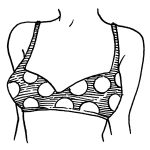The Last American Virgin (1982) overflows with quintessential teen-movie hijinks and motifs. There’s the malt shop and the locker room, the best friends jockeying for the same girl, and the crazy party where the fat kid falls in the pool. There’s the car that rolls into the water and the experiment with the prostitute. Bare breasts abound, but the movie’s real money-shot is a lush, full-frontal view of Karen, the curly-topped, painfully cute female lead. This scene takes place inside an abortion clinic.
The doctor, pockmarked and imperious, has just slipped on his gloves. Then the camera, starting at Karen’s thighs—a tousle of pubic hair visible over her panties—tilts up her bare torso to her face. She’s crying. This is a twisted turn-on—if you enjoy it like you’re supposed to, you’re no better than the callous jerk who knocked her up. The film’s obligation to its constituency of horny boys has run uncomfortably into its other obligation, to tell a story. The scene itself is like an adolescent, getting off without regard to context—a scenario familiar to any man who’s had pubescent run-ins with anatomy textbooks or the underwear section of the J. C. Penney catalogue.
Teen sex comedies—each of those words defined incredibly loosely—blossomed from 1982 to 1985.1 These movies burgeoned in the cultural airspace cleared by ’70s porn, back when porn thought it needed plot. Usually structured around a crude story about a group of high school or college students who want sex, and featuring plenty of nude or near-nude female bodies but no close-ups of genitals, sex comedies are like the nonalcoholic beer of porn. Twelve-year-olds may get intoxicated, but that’s about it. With a lose-our-virginity-or-bust belief system, the films and their characters pole-vault over ethics to get at sex—like they could crash maturity as they would a party. In the mid-’80s, the pole snapped. The movies didn’t have enough heart to make it, though the formula came out of retirement in 1999 to execute one improbably graceful vault in the form of American Pie.
Teens, sex, comedy: sounds like a new holy trinity of American popular culture. But these teens were, as sex-seeking robots, too one-dimensional to be sympathetic. And their ideas about sex were off-balance—a mixture of debauched aggression and deep weakness (even the repeatedly uttered goal of “getting laid” ultimately implies passivity). It’s sex without a connection—male-female relations as a grudge match. And it’s hard to appeal to the groin and the funny bone at the same time; the movies are, with a few exceptions, witless.
Screwballs is a paradigmatic teen titty-flick that, like many of its brothers, hasn’t made the transition to DVD. Casually set in the ’60s...
You have reached your article limit
Sign up for a digital subscription and continue reading all new issues, plus our entire archives, for just $1.50/month.
Already a subscriber? Sign in





